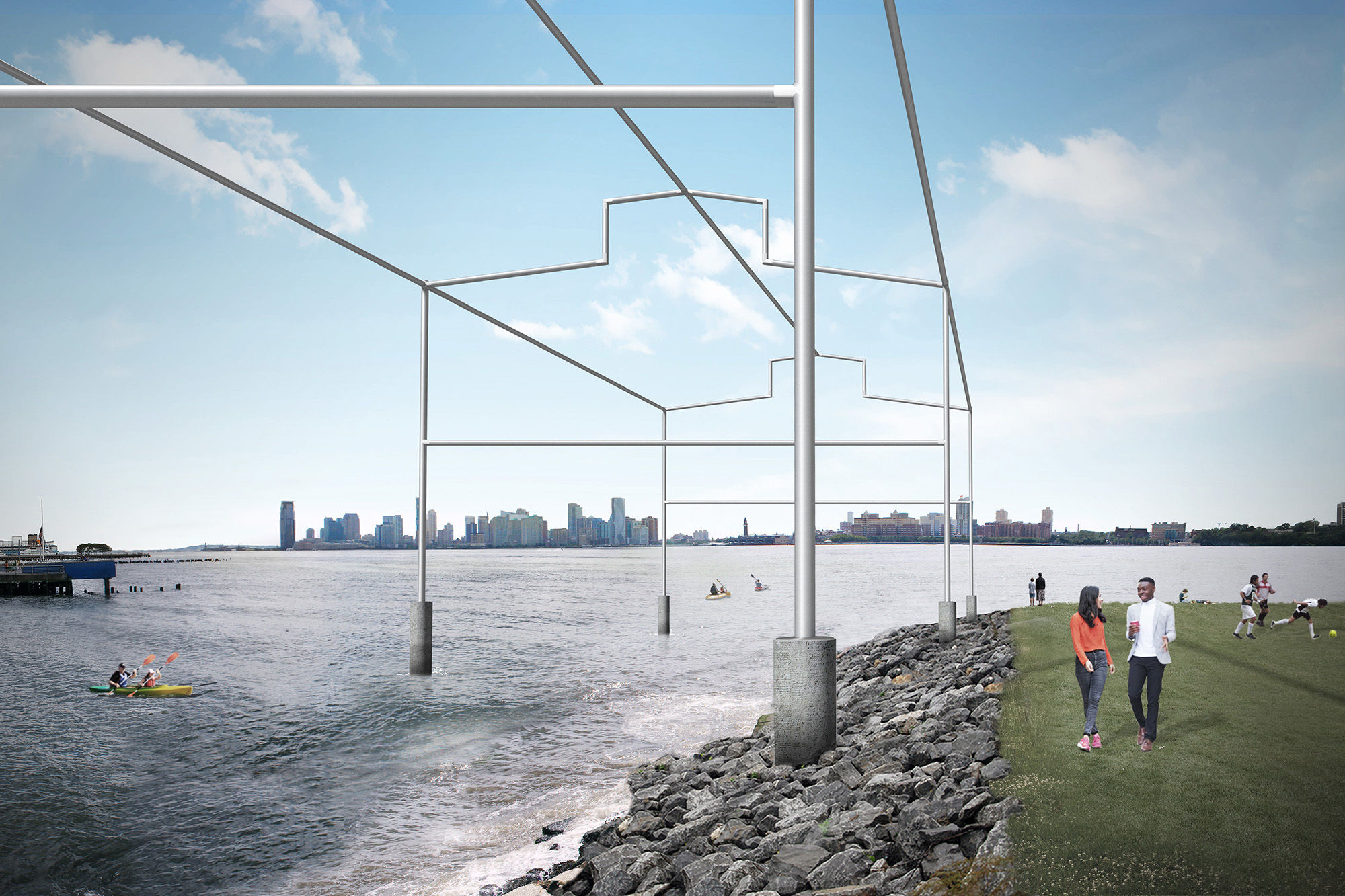
An ambitious permanent public art installation by David Hammons has been approved by the New York State legislature, moving it one step closer to becoming a reality. Senator Brad Hoylman, a Democrat, who introduced the bill amending the Hudson River Park Act to allow for the artwork’s construction, announced the legislation’s passage on Twitter yesterday.
The massive sculpture, located across the street from the Whitney Museum of American Art, which is spearheading the project, recreates the skeletal outlines of a 325-foot-long, 52-foot-tall shed that once stood on Pier 52, off Manhattan’s Gansevoort Peninsula—itself the remnants of what was once a much-longer 13th Avenue extending up through Chelsea.
“As we move ahead, we are extremely grateful for the tremendous support this project has received from the local community, elected officials, and many others,” a spokesperson for the museum told artnet News. “The Whitney is seeking public and private support for the planning, fabrication, and construction of this project.”
In 1975, Gordon Matta-Clark (1943–1978) turned the same abandoned pier—which had served as a hub of sexual exploration and freedom for New York’s gay community—into an artwork. He spent two months cutting five holes into the walls, transforming the building into what he dubbed a “sun and water temple.”
Hammons has named his piece Day’s End after the unauthorized Matta-Clark intervention. But much has changed since the ’70s: While the state granted Hammons official permission, the city actually took legal action against Matta-Clark because of the piece. (The charges were ultimately dropped.)
Gordon Matta-Clark, Day’s End (Pier 52) (Exterior with Ice), 1975, created by slicing holes in the exterior of a shed on Manhattan’s Pier 52. Photo courtesy of the Estate of Gordon Matta-Clark, Artists Rights Society (ARS), New York.
Jane Crawford, Matta-Clark’s widow, has voiced her approval of the project, telling the New York Times that “it’s very poetic, so beautiful. I’m so honored, as I know Gordon would be were he here.”
The Hammons project was first announced in September, and received tentative approval from Manhattan Community Board 2 in October. The New York State Assembly voted unanimously to approve it last month.
The Whitney will be responsible for constructing the artwork and paying for its upkeep and repair, but will donate the work to the Hudson River Park Trust, according to the legislation.
Gordon Matta-Clark making Day’s End (Pier 52) in 1975. Photo courtesy of the Estate of Gordon Matta-Clark, Artists Rights Society (ARS), New York, and David Zwirner, New York.
Made from thin poles of brushed stainless steel, the minimalist structure will blend into the water beyond it, becoming easier or more difficult to see based on the time of day and the weather. (It will not be illuminated.) The Whitney is billing it as “an extraordinary place to experience the waterfront and view the sunset.”
The museum describes the work as a “ghost monument” to the original Day’s End. It will celebrate the long history of the New York waterfront, from the heights of the shipping industry to its unofficial status as a gathering place for the gay community.
David Hammons, Day’s End (2015), sketch of the proposed project. Courtesy of the Whitney Museum of American Art.
In more recent years, the Gansevoort Peninsula was home to a city sanitation facility, demolished in 2016 ahead of the site’s transition into a park. The Hudson River Park Trust, established in 1998, is slowly but surely transforming the West Side waterfront between Battery Park City and 59th Street into parkland.
Day’s End, hovering over the water where Pier 52 once stood, will not encroach on the peninsula’s park, which is set to feature a rocky beach, a lawn, and recreational boating facilities. (The last remaining block of 13th Avenue is being preserved as part of the park design.)
Thomas Heatherwick’s rendering of Pier 55, or Diller Island. Image courtesy of Heatherwick Studio/Pier 55 Inc.
Just north of Pier 52, there are ambitious plans to build a floating island and performing arts hub, funded by Barry Diller, off Pier 54 at 13th Street. The proposal, called Pier 55 or Diller Island and designed by Thomas Heatherwick, was declared dead in September, only to be revived the following month thanks in part to Governor Andrew Cuomo, according to the Times. Construction on the project began in April.
The Whitney has not given a timeline for Day’s End; a spokesperson says there are still many layers of additional approval required. Our Town reported in October that the artwork would be constructed offsite, and would take eight to 10 months to complete. The piece will be accompanied by an explanatory app and onsite signage, as well as tours, publications, a documentary film, and oral histories featuring local residents.
See more renderings of the project below.
David Hammons, Day’s End (rendering). Image courtesy of Guy Nordenson and Associates.
David Hammons, Day’s End (rendering). Image courtesy of Guy Nordenson and Associates.
David Hammons, Day’s End (rendering). Image courtesy of Guy Nordenson and Associates.
David Hammons, Day’s End (rendering). Image courtesy of Guy Nordenson and Associates.
David Hammons, Day’s End (rendering). Image courtesy of Guy Nordenson and Associates.
David Hammons, Day’s End (rendering). Image courtesy of Guy Nordenson and Associates.